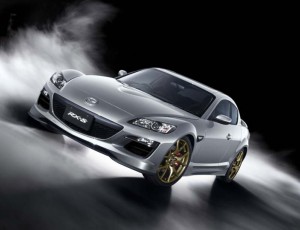With apologies to Mark Twain, reports of the death of the rotary engine are premature, though not greatly exaggerated. Mazda has decided to give its Wankel-powered RX-8 a temporary reprieve, adding an extra 1,000 units to its final run. But what happens beyond that is anything but certain.
While the Japanese maker has been hinting that a more advanced version of the ultra-compact powertrain is under development – this time borrowing some features from Mazda’s promising SkyActiv technology – it is anything but certain if or when a rotary will return to production.
As the Mazda RX-8 wraps up its ninth and final year of production, Mazda has decided to add another 1,000 units to the run to meet unexpected demand. The last cars will be part of the Japanese maker’s limited-edition Spirit R model, a heavily loaded model featuring such niceties as Recaro sport bucket seats, oversized red brakes and a leather-wrapped steering wheel.
Two-thirds of the final run will be equipped with a manual gearbox that also brings larger wheels and tires and a “hard” suspension for some serious driving. The Spirit R also gets an enhanced traction control system with track mode for minimizing that annoying brake intervention during hard cornering.
So buyers who opt for the automatic transmission don’t feel completely left out they still get a “sport” suspension and 8-way power seats.
Unfortunately, neither model will be offered in the U.S. during the extended final run.
First launched in April 2003, the surprisingly long-lived RX-8 was supposed to have wrapped up production last month but Mazda says it will now continue through June – barring another reprieve.
Mazda has turned the Wankel into a brand signature for more than four decades but the rotary engine appears to be a victim of its basic limitations. Shockingly small and able to rev up to phenomenal speeds it suffers from some basic physics issues that make it difficult to match the fuel efficiency of comparable piston engines.
Mazda officials, however believe they can make enough improvements using various Mazda SkyActiv technologies – to reduce friction, increase compression ratios and improve ignition – to bring the rotary back into the portfolio, company officials have hinted in recent months.
In fact, one alternative application might prove particularly useful, Mazda exploring the possibility of using the Wankel as a range extender in a plug-in hybrid. In such a situation a rotary would operate at a relatively steady engine speed as a generator providing electricity to drive a vehicle’s electric motors. It would not be directly connected to the wheels.
That approach could permit Mazda to maximize the efficiency of the rotary.
Senior officials recently told TheDetroitBureau.com that they’re continuing to work on the rotary even though it is not a formally approved project. But Mazda’s current financial problems complicate that development effort and likely means a new version wouldn’t be market-ready until at least mid-decade.
But that may work out perfectly. Mazda is looking to get as much life as possible out of SkyActiv – which it claims can deliver near-hybrid mileage without the added cost. But CEO Takashi Yamanouchi acknowledged, during the unveiling of the SkyActiv-powered Mazda CX-5, that the maker will eventually have to add battery technology to its powertrain portfolio in order to meet steadily increasing fuel economy requirements.
If Mazda can find a way to tune the rotary for a range-extender application it might just find new life in the line-up.

